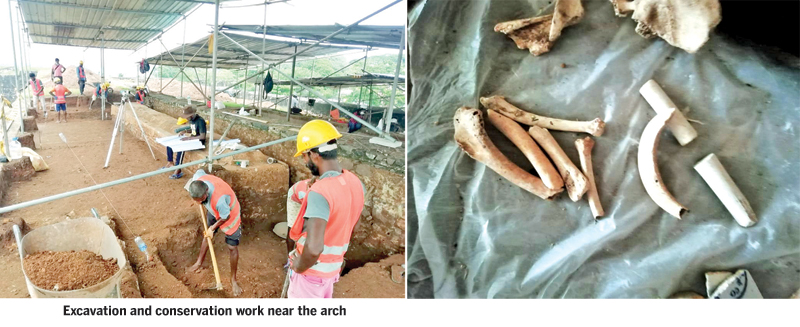Archaeological excavations carried out in parallel to the Galle Fort Conservation Project have uncovered a large number of antiquities, including broken pieces of special plates.
Doctor of Philosophy in Prehistory at the Sydney University, Australia Nimal Perera, who is in charge of the archaeological excavations, said this project has revealed a lot of valuable information.
Dr. Nimal Perera further stated that it has been revealed that the dish had been made in Italy. On the back of this dish is a note logo that includes the wording “Medici”. The Medici is a very prominent aristocratic family in Italy. The Medici family is the royalty of the country and had been involved in various businesses during the European Renaissance. Examination of their information reveals that even Popes were descended from this family. There had also been a type of flower pots named after their family and it is a special feature that in the broken plate found in the Galle Fort carries the name Medici. The numbers 1,5,5,1 are also written on the plate. However, it has not yet been confirmed the exact year of the dish production.
Archaeologist Nadeera Harshajith, an external lecturer at the Rajarata University, said the dish might have been imported by Europeans. He presumes that the Medici family in Italy might have had business relations with the Portuguese and Dutch in Sri Lanka.
However, further investigations are to be carried out. Excavations at the site have uncovered a large number of broken pottery, glass, chimneys, iron fragments, and animal bones.
The Urban Development Authority and the Department of Archeology jointly implement the Galle Fort Conservation Project.
Archaeological excavations at several sites, including the arch-shaped structures in the fort, uncovered important information about the equipment used by the European nations and the foodstuff they had, Dr. Perera further said.
Excavations have uncovered a large number of fragments of wine bottles and porcelain tobacco pipes. Examination of discarded bones reveals evidence that all edible animals, including cattle, sheep, pigs, crocodiles, fish, and oysters, were eaten by Europeans living in the Fort.
Excavations have also uncovered some metal parts such as horseshoes, nails and chains.
“Conservation work is being carried out at the main entrance to the Fort. The topsoil for the arch was removed and excavated up to the arch wall on both sides. Then the sidewalls of the arch were reinforced and the arch was reinforced with a specially prepared mortar mixture on top. This particular dish was found there.
The gates of the fort are closed these days. I had to do this as a precaution for the water leaking out of this gate. The gate will be reopened as soon as conservation work is completed,” Dr. Nilan Cooray, Chartered Architect, who is the Consultant on the Fort Conservation Project, further elaborated.
Excavations at the upper part of the gate, built by the British in the centre of the Fort, also uncovered a two-door design that could be used to lift or lower the door. However, archaeologists argue that no door was ever erected at the site.

Animal remains and porcelain pottery parts found during excavation at Galle Fort.


